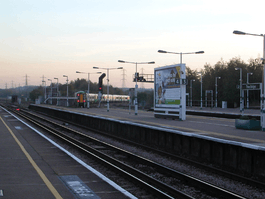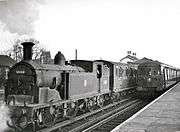Three Bridges railway station
| Three Bridges | |
|---|---|
|
| |
| Location | |
| Place | Three Bridges |
| Local authority | Borough of Crawley |
| Grid reference | TQ288369 |
| Operations | |
| Station code | TBD |
| Managed by | Southern |
| Number of platforms | 5 |
| DfT category | C1 |
|
Live arrivals/departures, station information and onward connections from National Rail Enquiries | |
| Annual rail passenger usage* | |
| 2004/05 | 2.011 million |
| 2005/06 |
|
| 2006/07 |
|
| 2007/08 |
|
| 2008/09 |
|
| 2009/10 |
|
| 2010/11 |
|
| 2011/12 |
|
| 2012/13 |
|
| 2013/14 |
|
| 2014/15 |
|
| History | |
| Key dates | Opened 12 July 1841 |
| Original company | London & Brighton Railway |
| Pre-grouping | London, Brighton & South Coast Railway |
| Post-grouping | Southern Railway |
| National Rail – UK railway stations | |
| * Annual estimated passenger usage based on sales of tickets in stated financial year(s) which end or originate at Three Bridges from Office of Rail and Road statistics. Methodology may vary year on year. | |
|
| |
Three Bridges railway station is located in and named after the village of Three Bridges, which is now a district of Crawley, West Sussex, England. It is at the point where the Arun Valley Line diverges from the Brighton Main Line and Thameslink 29 1⁄2 miles (47.5 km) south of both London Victoria and London Bridge.
History
The original Italianate style railway station on the East side of the line at Three Bridges was opened in July 1841 by the London and Brighton Railway at a point next to their proposed branch to Horsham. It was designed by the architect David Mocatta, and was one of a series of standardised modular buildings used by the railway.[1] This building was demolished 5 May 1985.[2] Mocatta's plans for the station indicate that it was originally going to be known as "Crawley"[3] but according to The London and Brighton railway guide, of 1841 and the 1846 timetable it was named "Three Bridges" from the time it was opened.[4]
Enlargement
The London and Brighton Railway merged with others to become the London Brighton and South Coast Railway in 1846, and the branch to Horsham was opened two years later. Three Bridges was enlarged in July 1855 with the construction of a branch line to East Grinstead and again enlarged in 1906/9 at the time of the quadrupling of the main line. The present ticket office was then built on the west side of the line and new platforms and station buildings for the new lines.
Electrification
Three Bridges was a key site for the electrification scheme for the Brighton main line during 1932/33, housing the control room for the scheme, and was one of three locations where current was taken from the national network and transmitted to substations.[5] Electric multiple unit trains began to run between London and Three Bridges on 17 July 1932. The line was electrified throughout on 30 December.[6] At the same time the practice of using "slip coaches" for East Grinstead at Three Bridges from expresses bound for the south coast was abandoned by the Southern Railway.[7] The line from Three Bridges to Horsham was electrified in May 1938.[8] The single-track branch line to East Grinstead was never electrified. It remained steam operated, using tank locomotives of the M7 and H classes hauling push–pull trains. After the end of steam operation in 1964, it was then briefly operated by diesel-electric multiple units of British Rail Class 205 but closed on 2 January 1967.
Accidents
There have been four recorded accidents at Three Bridges station, the first two of which were relatively minor and involved no injuries. On 12 April 1858 an engine collided with passenger carriages, and on 18 October 1863 an excursion train hit the buffer stops. Two members of station staff died on 13 December 1868 from an explosion of naphtha in a truck of a goods train.[9] On 28 January 1933 an electric train crashed into the back of a steam freight train waiting at the signal box. The driver of the electric train and the guard of the freight train were both seriously injured.[10]
|
Related rail facilities
Locomotive depot and goods yard

An engine shed was opened in July 1848 on a site to the west of the station. This was closed in 1909 to make way for the enlargement of the station and a new depot was established in the fork between the Brighton and Horsham lines in 1911, which remained open until June 1964.
The original small goods yard to the south of the station was greatly extended during the First World War and was used as a marshalling yard for munitions trains heading for the Continent. Trains from the Great Western Railway and the London and North Western Railway were brought here for onward transmission to Newhaven Harbour.[11]
In the early 2000s, Virgin CrossCountry built a depot at Three Bridges to service its Class 220 Voyagers.[12] It closed following CrossCountry withdrawing its Gatwick and Brighton services in December 2008.[13]
Three Bridges rail operating centre
In 2010 Network Rail selected Three Bridges as its preferred site for a signalling centre for trains operating in the southeast of England, being central to the London, Brighton, and future Thameslink services, and with no major negative planning issues.[14] A 1.7 ha (4.2 acres) site 0.5 mi (0.80 km) south of Three Bridges station was selected, located in the "fork" between the Arun Valley Line and Brighton Main Line (51°06′44″N 0°09′47″W / 51.1123°N 0.1631°W); the centre was located east of a DB Schenker rail depot, and east of proposed depot facilities for the Thameslink rolling stock programme trains, which was under planning development at the same time.[15][16] The operating centre build was designed as a 71.45 by 34.8 m (234.4 by 114.2 ft) three-storey building with 6,980 m2 (75,100 sq ft) of floorspace, providing railway operational and administrational and training facilities. Equipment was primarily on the ground floor, with the operation rooms on first and second floors.[17]
In December 2011, Network Rail began construction of a rail operating centre at Three Bridges, one of 14 countrywide intended to replace several hundred signalboxes; the Three Bridges centre was built to control rail operations in the Sussex area. The facility was constructed by C. Spencer Ltd, and was expected to employ around 600 people, with a 900-person net job benefit once complete.[18][19] The facility was officially opened in January 2014.[20]
Three Bridges rolling stock depot
In 2009 Network Rail submitted a planning application for a rolling stock depot including a three road shed for trains to be procured under the Thameslink rolling stock programme; rejection of the plans for a sister depot at Hornsey resulted in modified plans being submitted in 2011, with the Three Bridges depot expanded to a five road shed with additional stabling and facilities. As of August 2014, the depot is under construction.
Three Bridges today
The station remains an important junction on the Brighton Main Line throughout Southern Railway (Great Britain) and British Railways ownership. Train services are now provided by Southern and Thameslink train operating companies.
Facilities
Besides a booking hall, the station has refreshment facilities and shops, as well as toilets and accessibility lifts to platforms.
Platform layout
- Platform 1: - From Crawley to London via Redhill - Some fast services in the peaks
- Platform 2: - To London via Redhill / Down to Chichester (off-peak) (Up Slow) Some Terminus from Victoria (Down Slow)
- Platform 3: - To Horsham/Bognor/Crawley - Occasionally Brighton (Down Slow)
- Platform 4: - To Bedford - Most Thameslink and Fast Victoria services (Up Fast)
- Platform 5: - To Brighton and/or Eastbourne and/or Littlehampton (Down Fast)
Services
The typical service from the station (Monday to Friday Off-Peak and Saturday) is:
- 4tph (trains per hour) to Haywards Heath and Brighton
- 2tph to London Victoria
- 4tph to Bedford
- 2tph to Horsham
- 2tph to London Bridge via Redhill
- 1tph to Southampton Central and Bognor Regis, running via and splitting at Horsham
- 1tph to Portsmouth Harbour and Bognor Regis, running via and splitting at Horsham
The typical service from the station (Sunday Off-Peak) is:
- 2tph to Haywards Heath and Brighton
- 1tph to London Victoria
- 2tph to Bedford
- 1tph to Horsham
- 1tph to London Bridge via Redhill
- 1tph to Bognor Regis, running via Horsham
| Preceding station | |
Following station | ||
|---|---|---|---|---|
| Gatwick Airport | Southern Arun Valley Line |
Crawley | ||
| Gatwick Airport | Southern West Coastway Line |
Crawley | ||
| Southern Brighton Main Line Sundays, some Saturday services & Mondays-Fridays peak hour only |
Balcombe | |||
| Thameslink Thameslink |
Balcombe or Haywards Heath | |||
| Disused railways | ||||
| Terminus | British Rail Southern Region Three Bridges to Tunbridge Wells Central Line |
Rowfant | ||
References
- ↑ Turner, John Howard (1977). The London Brighton and South Coast Railway 1 Origins and Formation. Batsford. ISBN 0-7134-0275-X. p.128.
- ↑ Chi Trevor. "Chi Trevor's Photostream". Retrieved 30 July 2010.
- ↑ Cole, David (1958). "Mocatta's stations for the Brighton Railway". Journal of transport history. Manchester: Manchester University Press. 5: 149–157. ISSN 0022-5266.
- ↑ "The London and Brighton railway guide, containing a correct description of the railway, historical and topographical notices of the places contiguous to the various stations, 1841". JSTOR 60240078. .
- ↑ Moody, G.T. (1968). Southern Electric 1909-1968. Ian Allan. p. 53.
- ↑ Moody (1968), pp.52-4.
- ↑ Kidner, R.W. (1984). Southern Suburban Steam. Oakwood Press. p. 11. ISBN 0-85361-298-6.
- ↑ Moody (1968), pp.68.
- ↑ Board of Trade Accidents: inspecting officers' reports for 1866-1871. pp.109-112.
- ↑ "Report on the Accident at Three Bridges on 28th January 1933". The Railways Archive.
- ↑ Bradley, D.L. (1974). The Locomotives of the London Brighton and South Coast Railway. Part 3. Railway Correspondence and Travel Society. p.133.
- ↑ 2001-2002 Bon Voyage(r) 1S76
- ↑ 2008 The end is nigh 1S76
- ↑ Network Rail & ARUP 2011, Planning Statement. 2.2, p.6; B1, pp.81-83.
- ↑ Network Rail & ARUP 2011, Planning Statement. 2.3.1, p.8; 3.1.1, p.9; Fig.1, p.10.
- ↑ Network Rail & ARUP 2011, (3BR-GX-205 04) Site Plan with TBOC.
- ↑ Network Rail & ARUP 2011, Design and Access Statement. 4. pp.20-21.
- ↑ "Bringing 900 jobs to Three Bridges". Network Rail. 12 December 2011.
- ↑ Work Starts on Three Bridges Rail Operating Centre: 900 Jobs to Follow, Network Rail, 12 December 2011
- ↑ Rail operating centre officially opened in Three Bridges, Network Rail, 7 Jan 2014
Sources
- Network Rail; ARUP (10 February 2011), (CR/2011/0075/FUL) CONSTRUCTION OF A 6,890 SQM THREE STOREY OPERATING CENTRE ..., Crawley Borough Council
External links
![]() Media related to Three Bridges railway station at Wikimedia Commons
Media related to Three Bridges railway station at Wikimedia Commons
- Train times and station information for Three Bridges railway station from National Rail
Coordinates: 51°07′01″N 0°09′40″W / 51.117°N 0.161°W


